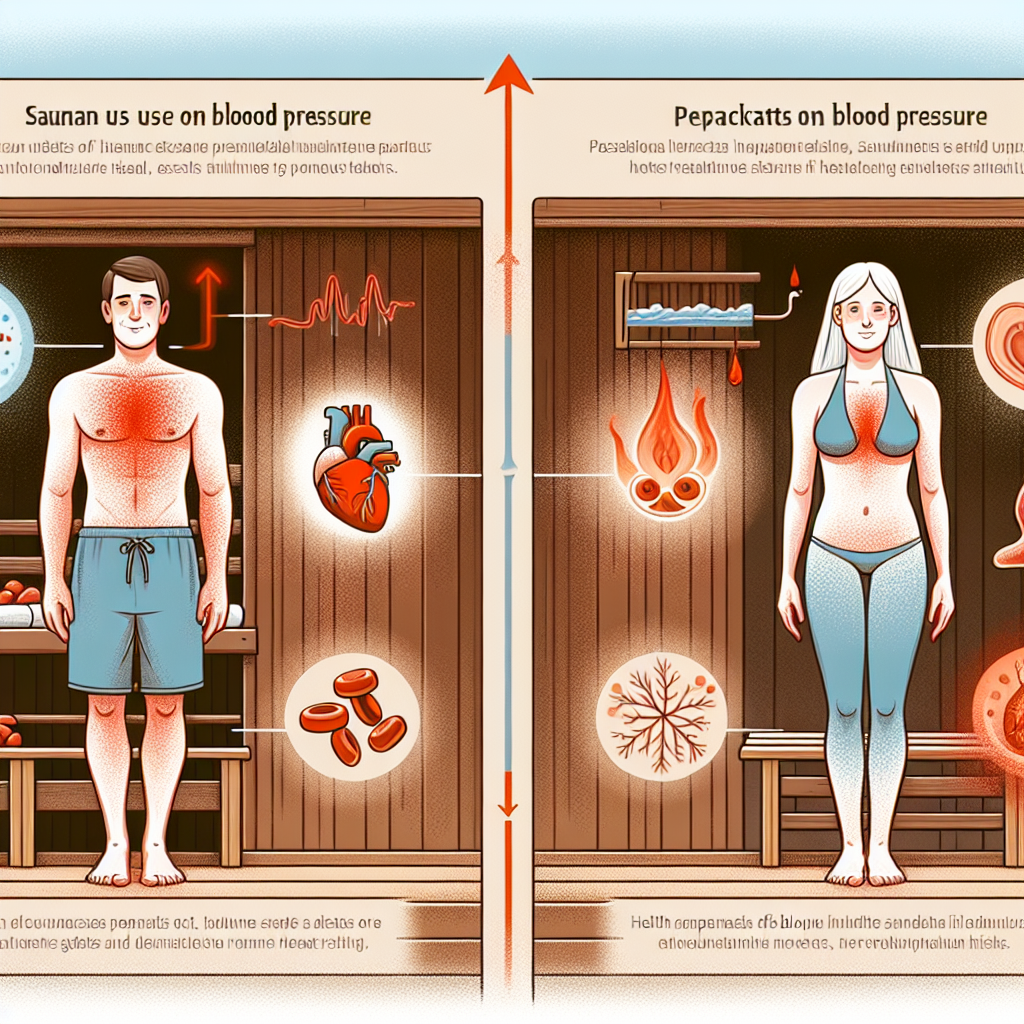Saunas might be synonymous with relaxation and stress relief, but did you know that they can also have a significant impact on your blood pressure? Yes, that’s right! Saunas have been found to offer a range of benefits for those dealing with high blood pressure. In this article, you will explore the fascinating relationship between saunas and blood pressure and uncover how this centuries-old practice can potentially improve your cardiovascular health. So, get ready to discover the surprising ways in which saunas can positively influence your blood pressure levels!

Sauna Basics
What is a sauna?
A sauna is a small, enclosed room or space designed to help you relax and promote overall well-being. It is typically heated to high temperatures, which causes your body to sweat. Saunas have been used for centuries in many cultures around the world for their therapeutic benefits. They can be found in various settings, such as gyms, health clubs, and even people’s homes.
How does a sauna work?
Saunas work by creating an environment of high heat, usually ranging from 80 to 100 degrees Celsius (176 to 212 degrees Fahrenheit). The heat is usually generated by a stove or electric heater that heats the rocks or coals in the sauna. As the rocks heat up, water is poured over them, creating steam and further increasing the temperature.
When you enter a sauna, the high temperature causes your body to start sweating profusely. This process helps to eliminate toxins from your body through the excretion of sweat. Additionally, the heat increases blood flow and dilates your blood vessels, promoting better circulation.
Types of saunas
There are several types of saunas available, each with its unique characteristics and benefits. The most common types include:
-
Traditional Finnish Sauna: This is the classic type of sauna, usually made of wood and heated by a stove or electric heater.
-
Infrared Sauna: Also known as a far infrared sauna, it uses infrared light to heat your body directly, rather than heating the air like in a traditional sauna.
-
Steam Room: Similar to a sauna, but with higher humidity levels, steam rooms are filled with moist air created by a steam generator.
-
Dry Sauna: This type of sauna has extremely low humidity levels, making it ideal for those who prefer a drier heat.
Impact on Blood Pressure
Immediate effects of sauna on blood pressure
When you enter a sauna, the high temperatures cause your body to sweat and your heart rate to increase. As a result, your blood vessels dilate, leading to a drop in blood pressure. This drop in blood pressure can provide immediate relief for those with hypertension or high blood pressure.
Long-term effects of sauna on blood pressure
Regular sauna use has shown promising long-term effects on blood pressure regulation. Studies have demonstrated that consistent sauna sessions can lead to a reduction in both systolic and diastolic blood pressure readings. This decrease in blood pressure may help to improve overall cardiovascular health and reduce the risk of heart disease.
Mechanisms Behind the Impact
Increase in body temperature
When you expose your body to the high temperatures of a sauna, your body temperature naturally rises. This increase in body temperature triggers various physiological responses, including an increase in heart rate and blood flow. These responses contribute to the temporary drop in blood pressure experienced during a sauna session.
Blood vessel dilation
One of the key mechanisms behind the impact of saunas on blood pressure is the dilation of blood vessels. The heat from the sauna causes your blood vessels to expand or dilate, allowing blood to flow more freely. This dilation of blood vessels helps to reduce resistance to blood flow and can contribute to lower blood pressure levels.
Fluid loss
Sitting in a sauna for an extended period can cause significant sweating, resulting in fluid loss from your body. This fluid loss can lead to a temporary decrease in blood volume, which can contribute to a drop in blood pressure. However, it is crucial to rehydrate adequately after a sauna session to maintain proper fluid balance.
Relaxation and stress reduction
Saunas are well-known for their relaxation and stress-reducing effects. When you enter a sauna, it provides a peaceful environment that encourages relaxation and promotes the release of endorphins, the body’s natural feel-good chemicals. This relaxation response can help to lower stress levels, which in turn can positively impact blood pressure.
Benefits for Hypertension
Lowering blood pressure levels
The immediate and long-term effects of saunas on blood pressure levels make them beneficial for individuals with hypertension. Regular sauna use, along with other lifestyle modifications, may help to bring blood pressure readings within a healthy range.
Improving cardiovascular health
High blood pressure is a significant risk factor for cardiovascular diseases such as heart attacks and strokes. By reducing blood pressure levels, saunas can contribute to improving overall cardiovascular health and reducing the risk of heart disease.
Reducing risk of heart disease
Multiple studies have shown a correlation between sauna use and a lower risk of heart disease. A Finnish study published in JAMA Internal Medicine found that men who used the sauna regularly had significantly lower rates of coronary heart disease and fatal cardiovascular events compared to men who used the sauna less frequently.

Risks and Precautions
Caution for hypertensive individuals
While saunas have potential health benefits, it is crucial for individuals with hypertension to exercise caution. Before incorporating sauna use into your routine, consult with your healthcare provider to ensure it is safe for you. They can provide guidance on the duration and frequency of sauna sessions that are appropriate for your health condition and medications.
Dehydration and electrolyte imbalance
Sauna sessions can lead to significant sweating, which can cause dehydration and electrolyte imbalances. It is essential to drink plenty of water before, during, and after a sauna session to replenish lost fluids. Additionally, consuming electrolyte-rich beverages or foods can help restore electrolyte balance in your body.
Heat intolerance and overheating
Some individuals may have difficulty tolerating the high temperatures of a sauna, increasing the risk of overheating. It is important to listen to your body and exit the sauna if you feel lightheaded, dizzy, or excessively fatigued. Start with shorter sauna sessions and gradually increase the duration as your tolerance builds.
Research and Studies
Scientific studies on sauna effects
Numerous scientific studies have examined the effects of saunas on various health parameters, including blood pressure. A study published in the Journal of Human Hypertension showed that sauna bathing for 30 minutes led to a significant decrease in both systolic and diastolic blood pressure in individuals with hypertension.
Clinical trials with blood pressure measurements
Clinical trials have also been conducted to evaluate the impact of saunas on blood pressure. A randomized controlled trial published in the American Journal of Hypertension found that regular sauna use over a 3-month period resulted in a significant reduction in systolic and diastolic blood pressure readings.
Sauna Recommendations
Duration and frequency of sauna sessions
The recommended duration and frequency of sauna sessions can vary depending on individual health and tolerance. As a general guideline, start with shorter sessions of around 10-15 minutes and gradually increase to 20-30 minutes as you acclimate to the heat. Engaging in sauna bathing 2-3 times a week can provide substantial benefits for blood pressure regulation.
Safety guidelines for sauna use
To ensure a safe sauna experience, it is essential to follow these safety guidelines:
-
Stay hydrated: Drink plenty of water before, during, and after your sauna session to prevent dehydration.
-
Take breaks: Listen to your body and take short breaks outside the sauna if you feel lightheaded or excessively fatigued.
-
Keep it clean: Saunas can be breeding grounds for bacteria and fungi. Always sit on a clean towel and wipe down the benches before use.
-
Avoid alcohol and drugs: Saunas can intensify the effects of alcohol and certain medications, leading to dizziness or fainting. It is best to avoid these substances before a sauna session.
-
Precautions for pregnant women and children: Pregnant women and young children should consult with a healthcare professional before using a sauna, as their bodies may be more sensitive to the high temperatures.
Other Factors to Consider
Individual health factors
It is important to consider your overall health and any pre-existing medical conditions before using a sauna. Individuals with certain conditions, such as uncontrolled hypertension, heart disease, or skin conditions, may need to avoid sauna use or consult with their healthcare provider beforehand.
Sauna temperature and humidity
Different types of saunas offer varying temperatures and humidity levels. It is important to choose a sauna that suits your comfort level and health needs. If you have any respiratory conditions or difficulty tolerating high heat, opting for a lower temperature or humidity sauna may be more suitable.
Combining sauna with lifestyle changes
While saunas can provide benefits for blood pressure, they should not be seen as a standalone solution. Incorporating sauna use into a comprehensive approach that includes regular exercise, a balanced diet, and stress management techniques can maximize the benefits for blood pressure regulation and overall well-being.
Conclusion
Saunas offer a range of benefits for individuals with hypertension. The combination of immediate blood pressure reduction, long-term effects on cardiovascular health, and stress reduction contribute to their positive impact. However, it is crucial to consult with a healthcare provider, stay hydrated, and practice caution to ensure a safe and effective sauna experience. Remember to listen to your body, start slowly, and enjoy the many benefits that saunas can offer for your blood pressure and overall health.

